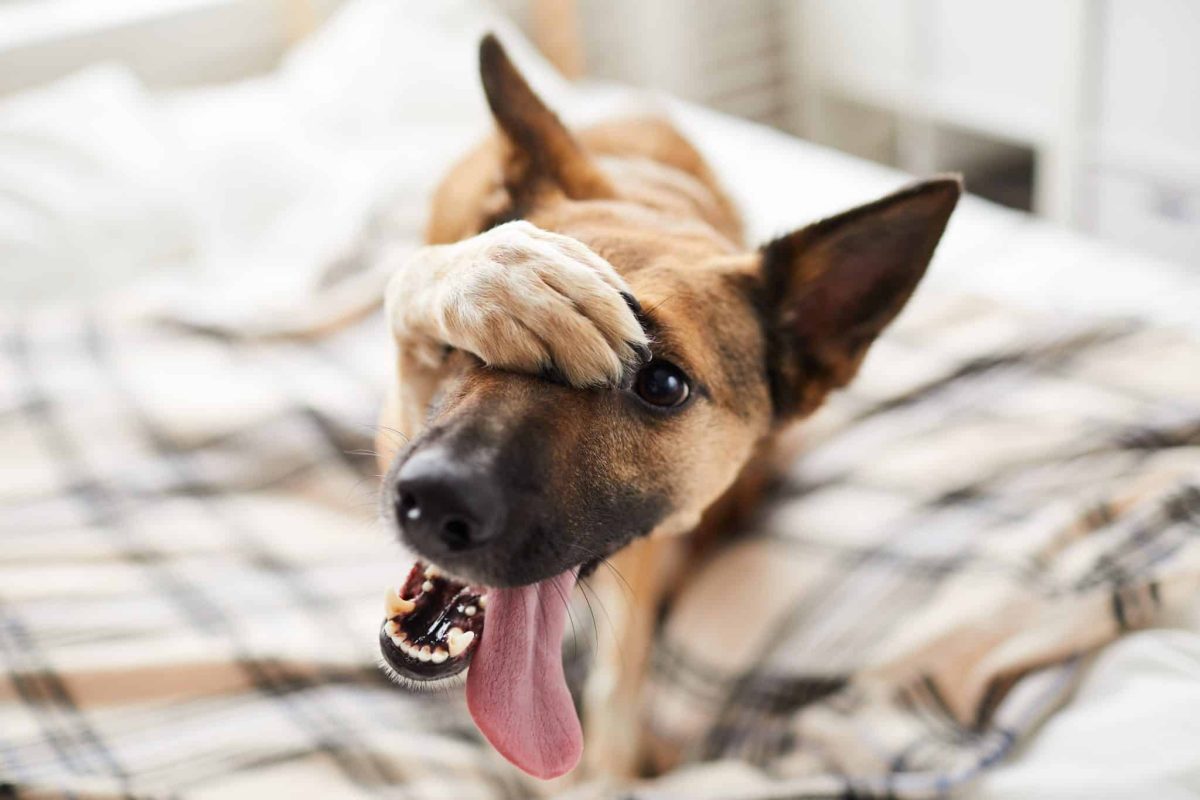 Shutterstock
Shutterstock
We often think of dogs as carefree and confident, but even our four-legged companions have moments of emotional vulnerability. Just like humans, dogs can feel awkward or unsure—especially when they’ve done something clumsy, unexpected, or out of character. While they don’t process emotions in quite the same way we do, their behavior reveals a lot about how they’re feeling inside. Understanding these subtle cues can help us better connect with and comfort our furry friends.
 Shutterstock
Shutterstock
One of the most common signs of canine embarrassment is avoiding your gaze. If your dog does something they perceive as wrong—like knocking over their water bowl or slipping on the floor—they might look away or turn their head. This can be their way of showing submission or trying to hide from an uncomfortable moment. It’s an instinctual response that often mirrors the behavior of a human feeling sheepish.
Hides or Retreats to Their Bed
 Shutterstock
Shutterstock
Dogs may physically remove themselves from a situation that made them feel awkward or uncertain. Whether it’s diving under the couch or retreating to their favorite hiding spot, this reaction is a clear sign they’re trying to escape attention. It’s a coping mechanism that allows them to recover from emotional stress. Just like us, dogs sometimes want to be alone when they’re feeling flustered.
Shows the “Guilty” Look
 Shutterstock
Shutterstock
That classic “guilty dog” face—droopy ears, lowered head, big eyes—often appears after a dog feels they’ve messed up. While they may not feel guilt the same way humans do, this expression shows that they sense your disapproval or the tension in the room. It’s a way of showing submission and trying to win back your favor. Many pet owners mistakenly read this as shame, but it’s more about social cues and communication.
Licks Their Lips or Yawns Excessively
 Shutterstock
Shutterstock
Lip licking and yawning are known as calming signals in the dog world. These actions often pop up when your pup feels stressed, uncomfortable, or emotionally off-balance. After an embarrassing tumble or a failed jump onto the couch, your dog might do one or both as a self-soothing tactic. It’s subtle, but very telling if you know what to look for.
Walks Away Slowly With Head Down
 Shutterstock
Shutterstock
If your dog casually strolls away after a flub, with their head low and tail neutral or tucked, they’re not just being nonchalant—they’re likely feeling a bit embarrassed. This behavior suggests they want to distance themselves from the moment. It’s the dog version of “nothing to see here.” They’re trying to reestablish calm and avoid further attention.
Rolls Over Submissively
 Shutterstock
Shutterstock
Sometimes, when dogs feel awkward or unsure, they flip onto their backs in a submissive posture. This is especially true if they’re being watched after a clumsy or disruptive incident. It’s a way of saying, “I mean no harm” or “please don’t be upset.” While it’s also a sign of trust, in certain contexts it reflects emotional discomfort.
 Shutterstock
Shutterstock
When a dog is unsure about their emotional standing, they may suddenly become very attached to you. They might lean on your leg, follow you from room to room, or nuzzle into your side. This can be a request for reassurance and a way to restore their sense of connection. Affection from their favorite human goes a long way toward soothing embarrassment.
Suddenly Becomes Quiet
 Shutterstock
Shutterstock
A typically energetic or vocal dog going silent can signal emotional distress. After a socially awkward moment, your pup might stop barking, playing, or responding in their usual lively way. This change in demeanor shows they’re emotionally impacted and might need some quiet time. Pay attention—it’s their version of sulking.
Acts “Overly Cool” After a Blunder
 Shutterstock
Shutterstock
You’ve probably seen it: your dog misses a jump or miscalculates a turn, then casually sniffs the ground like nothing happened. This “play it cool” act is surprisingly common and quite telling. Dogs instinctively try to divert attention by doing something ordinary after a misstep. It’s a charming example of canine social savvy.
Sits or Lies Down and Won’t Move
 Shutterstock
Shutterstock
A dog feeling awkward might freeze in place, especially if they think they’re being scolded or laughed at. This physical stillness can be their version of shutting down emotionally. They’re trying to figure out what just happened and how they should react. A little encouragement and a gentle tone can help coax them back to normal.
Sneezes or Shakes Off
 Shutterstock
Shutterstock
These behaviors are like emotional resets for dogs. After a moment of tension or discomfort—like a failed trick or slipping in front of company—they might sneeze or do a full-body shake. It’s their way of releasing built-up stress and moving on. Think of it as the dog equivalent of taking a deep breath.
Humps Objects (Oddly Enough)
 Shutterstock
Shutterstock
Sometimes, when overwhelmed or embarrassed, dogs might redirect that tension into an unusual behavior like humping. While often associated with dominance or play, this action can also be a nervous response. If your pup suddenly does this after a strange or stressful moment, it may be their way of dealing with internal confusion. It’s awkward for everyone involved, but not necessarily a sign of misbehavior.
Tries to Distract With Play
 Shutterstock
Shutterstock
Dogs that feel uneasy may try to redirect the mood with a spontaneous burst of playfulness. They might bring you a toy or perform a goofy bow to lighten the vibe. It’s a clever way to shift focus and mend social bonds. Your dog’s invitation to play is often a request for emotional reassurance.
Paws-itively Still Adorable
 Shutterstock
Shutterstock
Even when they’re feeling awkward or unsure, dogs have an uncanny way of melting our hearts. Their emotional intelligence and sensitivity to social cues are just part of what makes them such lovable companions. Whether they’re avoiding eye contact or pulling a silly stunt to play it off, every gesture tells a story. So next time your pup shows a moment of bashfulness, give them a reassuring pat—they’re doing their best to navigate a very human-like emotion.

 1 month ago
14
1 month ago
14


















 English (US) ·
English (US) ·